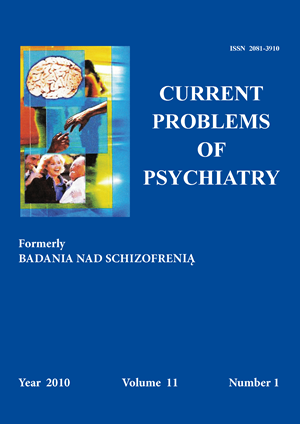Charakterystyka wybranych cech wypowiedzi osób chorych na schizofrenięAnaliza porównawcza z wykorzystaniem Wskaźników Stylów Mówienia Suitberta ErtelaWstępne doniesienie z badań
Słowa kluczowe:
paranoid schizophrenia, speech styles, quantitative linguistic analysisAbstrakt
The goal of the research is comparative analysis of spoken utterances of schizophrenic patients with negative syndromes, with positive syndromes (research group) and healthy people (control group). The analysis aims at identifying speech styles characteristic to both groups and is based on quotients proposed by Ertel.
Method: The procedure applied by Ertel consisted in comparing the frequencies of word forms belonging to specific classes with frequencies of word forms from contrastive classes. The quotients applied by Ertel include: Impersonal Reference Quotient, Plural Quotient, Classification Quotient, Nominalization Quotient, Abstractness Quotient, and Dogmatism Quotient. The details of quotients’ computation were adapted to the specificity of the research material and to Polish language properties. In our research all the quotients were calculated on the basis of gathered linguistic material, separately for each person, the average was calculated for each group – negative patients, positive patients and control group – and compared with the use of test t, α=0,05.
Results and conclusion: The comparative analysis of the quotients’ values shows some significant differences between speech styles of schizophrenic patients from both subgroups and healthy people, particularly in the case of Impersonal Reference Quotient, Nominalization Quotient, Abstractness Quotient, and Dogmatism Quotient.
Bibliografia
1. Andreasen N. Scale for the Assessment of Negative Syndroms (SAPS). Iowa City: University of Iowa; 1984.
2. Andreasen N. Scale for the Assessment of Positive Syndroms (SAPS). Iowa City: University of Iowa; 1984.
3. Andreasen N., Crow T. Thought, language and communication disorders. Clinical assessment, definition of terms and evaluation of their reliability. Arch. Gen. Psychiatry, 1979; 36: 1315-1321.
4. Baschek L., Bredenkamp J., Öhrle B., Wippich W. Bestimmung der Bildhaftigkeit, Konkretheit und der Bedeutungshaltigkeit von 800 Substantiven. Z. Exp. Angew. Psychol., 1977; 24: 99-142.
5. Birchwood M., Jackson Ch. Schizofrenia. Gdańsk: Gdańskie Wydawnictwo Psychologiczne; 2004.
6. Ertel S. Language, thought and culture: Toward a mergence of diverging problem fields. W: Kurcz I., Shugar G.W., Danks J.H. red. Knowledge and Language. Amsterdam: Elsevier Science Publishers; 1986. s. 139-163.
7. Janusz B., Gdowska K., de Barbaro B. Narracja. Teoria i praktyka. Kraków: Wydawnictwo Uniwersytetu Jagiellońskiego; 2008.
8. Kępiński A. Schizofrenia. Kraków: Wydawnictwo Literackie; 2001.
9. Klasik A., Krupka-Matuszczyk I., Krysta K. Procesy poznawcze człowieka – norma a schizofrenia. Warszawa: Agencja Reklamowo-Wydawnicza; 2005.
10. Kurcz I. Język a reprezentacja świata w umyśle. Warszawa: Państwowe Wydawnictwo Naukowe; 1987.
11. Obrębska M. Myślenie stereotypowe w normie i w patologii. W: Domachowski W. red. Stereotypy i stereotypizacja, Poznań: Wydawnictwo Naukowe UAM, seria Człowiek i Społeczeństwo, tom XXVII; 2007. s. 135-145.
12. Obrębska M. Wielka Narracja Schizofrenika. W: Straś-Romanowska, Bartosz B., Żurko M. red. Życie człowieka w wielkich i małych narracjach. (materiał nieopublikowany); 2009.
13. Obrębska M., Obrębski T. Lexical and Grammatical Analysis of Schizophrenic Patients’ Language: A Preliminary Report. Psychology of Language and Communication, 2007; 11.1: 63-72.
14. Obrębski, T., Stolarski, M. UAM Text Tools - A Flexible NLP Architecture. W: Calzolari N. red. Fifth International Conference on Language Resources and Evaluation. Paris: ELRA; 2006. s. 2259-2262.
15. Pennebaker J.W., Mehl M.R., Niederhoffer K.G. Psychological aspects of natural language use: our words, our selves. Annu. Rev. Clin. Psychol., 2003; 54: 547-577.
16. Pennebaker J.W., Stone L.D. Words of Wisdom: Language Use Over the Life Span. J. Pers. Soc. Psychol., 2003; 85/2: 291-301.
17. Rokeach M. The Open and Closed Mind. Investigation into Nature of Belief Systems and Personality Systems. New York: Basic Books; 1960.
18. Trzebiński J. Narracja jako sposób rozumienia świata. Gdańsk: GWP; 2002.
19. Wciórka J. Schizofrenia. W: Bilikiewicz A., Pużyński S., Rybakowski J., Wciórka J. red. Psychiatria, t.2. Wrocław: Wydawnictwo Medyczne Urban & Partner; 2002. s. 213-277.
20. Zeigarnik B.W. Patologia myślenia. Warszawa: Państwowe Wydawnictwo Naukowe; 1969.


